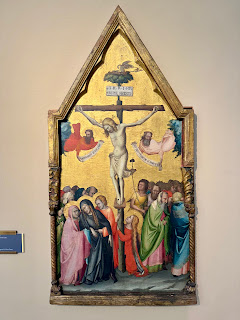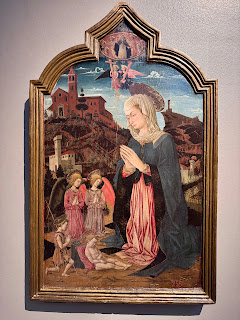Before our departure from Bologna (pop 390,850 in 2024), we squeeze in a visit to the Pinacoteca Nazionale (17th century). Near the Via delle Belle Arti, we pass a street-art mural painted in a faux arch; the subject is the Canale di Reno (just a block or two away), complete with painted inhabitants.
This is a preview for the Pinacoteca, which is famous for its frescos. It's housed in an old convent, the former Noviziato Gesuitico e Chiesa di Sant’Ignazio. The ceiling mural over the stair hall, "Gloria di Sant’Ignazio" (Giuseppe Barbieri, 1660/75), is a remnant of its previous incarnation.
The gallery show drops us into the late medieval, with some lyrical imagery. The "Visione di San Romualdo" (Maestro dei Polittici Bolognesi, c1329) is the dreamy sight of white-robed monks climbing to Heaven, in unearthly pinks and gold. The surreal portrayals continue with "Crocefissione e i santi Giacomo, Bartolomeo, Agostino e Stefano" (Maestro dei Polittici Bolognesi, c1340), with the wily, mask-like faces.
The figures in "Gesù Cristo crocifisso e dolenti" (Dalmasio, 1335/40) seem to float on the gilded background, at the top of the Cross is a stork's nest and a dragon in the distance. The figures in the "Madonna col Bambino, angeli e il donatore Giovanni da Piacenza" (Simone di Filippo, c 1378) convey wildly contrasting scales.
The two leaves of the "Storie di Cristo e Santi" and the "Storie della Passione" (Maestro di San Nicolò degli Albari, c1320) further divide into ten panels and read exactly like a comic book.
Two triptychs exemplify the idea of a mobile altarpiece: "Trittico" (Dalmasio, c1390) and "Santi Pietro e Giovanni Battista. [in alto] La Vergine Annunziata" (Jacopo di Paolo, 1400/10). The central panels appear to work like inserts between the side leaves. The presentations, while still fantastical, fit the architecture of the triptych, and are full of amazing detail and portraiture. Note the 'Jacopo di Paolo' piece is signed, and the patron still appears as a smaller dark figure underneath le scale di San Michele.
The gallery is dominated by the"Crocifisso [Croce sagomata col Padre Eterno, l'Addolorata, San Giovanni e San Francesco]" (Giovanni da Modena, c1415). With the bloody Jacopo di Paolo Crocifisso fresh in our minds, we are struck by the unusual 'laser show' in the lower trefoil – San Francesco evidently receiving the stigmata from a glowing, red angel.
Finally, we reach the gallery room with the "Polittico [Madonna col Bambino e Santi]" (c1330), an altarpiece painted by Giotto for the Cappella Magna del Palazzo Apostolico. Almost shocking in its simplicity and clarity, the Polittico contains four saints, labelled: Scs Petrus (keys), Scs Ghabriel (scroll, "Ave gratia plena"), Scs Micchael (defeating dragon), and Scs Paulus (sword).
The predella is used as a platform separate from the five panels, portrait inside the roundels (left to right): San Giovanni Battista (pointing to the Child), la Madonna (blue cape), il Cristo della Passione (center), San Giovanni Evangelista, and Maria Maddalena. The Polittico represents Christ in His early youth and in His passing.
Sharing the gallery with the Polittico, the "Giudizio Universale. [in basso] Cristo con i simboli della Passione" (Maestro della Misericordia, 1360/65) is stiff and almost cryptic in its symbology, suggesting perhaps a path toward someone like Hieronymus Bosch. But with the "Última Cena" (Andrea di Bartolo, c1420), we truly arrive in the Proto Renaissance and begin to see an attempt to represent a 'realistic' architectural setting. Judas, unconcerned and looking away at the opposite end of the table from Christ, even appears to be smoking (?).
Coming out the small gallery, a docent notices our excitement and tells us not to miss Sala 21. We assume he means there's more Giotto, so we head back to Sala 21, where we find "L'Orlando Furioso [Gli Affreschi di Palazzo Torfanini]" (Niccolò dell'Abate, c1548, relocated from Via Galliera), a series of Late Renaissance fresco fragments illustrating the poem by Ludovico Ariosto (published 1516). The frescos are a series of Ionic archways at sunset, decorated with floral swags and monumental sculptures.
"Alcina riceve Ruggero nel suo castello" is on the left side, in which the evil sorceress Alcina plies her magical beauty on our hero, Ruggiero; next is "Ruggero fugge dal castello di Alcina", where he escapes the sorceress and heads to the kingdom of Logistilla. "Ruggero diretto al castello di Logistilla" is on the right wall, where just enough remains of the panel to see Alcina's fleet (blinded by reflected light?), and the cannon fire from the castle. Finally, "Battaglia fra la flotta di Logistilla e quella di Alcina", Alcina's broken ships scatter, and the triumphant Ruggiero enters the castle.
An intriguing installation, but we think the docent has very specific different tastes. We're unsure of the connection to Giotto, but perhaps the poem is a local favorite, and in all cases, virtue prevails.
Making our way back through the gallery we revisit the "Crocifisso [Croce sagomata con la Madonna tra Angeli, San Francesco e Sant'Elena]" (Jacopo di Paolo e Maestro dei Crocefissi Francescani, c1254) which is reminiscent of the Crucifixes by Cimabue (S Franciscus reappears at the base of the Cross). The "Madonna in trono col bambino fra i Santi Girolamo e Petronio" (Lianori Pietro, 1453, full image) includes an excellent portrait of San Petronio with a large architectural model of the Due Torri.
There are additional suggestions of Bosch-like imagery in "Paradiso e Inferno" (Maestro dell'Avicenna, c1435) and the wonderful "Trionfo del Tempo" (Zanobi di Benedetto di Caroccio degli Stozzi, 1440/45) – notice the towers and hills reflected in "Tempo's" crystal ball.
We rejoin the Proto Renaissance in the Salone degli Affreschi Trecenteschi, where the frescos continue. The "Madonna col bambino e San Giovanni Evangelista" (Andrea de' Bruni, 1360/65, Ospizio di San Giuseppe / Chiesa di Santa Maria Maddalena) is from a ruined church, the current site of the Arena del Sol. The dramatic "San Giacomo alla battaglia di Clavijo" (Mestro della Crocefissione Campana, 1315/20, Chiesa di San Giacomo Maggiore) looks like an inspiration for the L'Orlando Furioso cycle.
The "Última Cena [e i santi Caterina, Ludovico di Tolosa, Antonio da Padova e Raffaele Arcangelo]" (Vitale da Bologna, c1340, Convento di San Francesco) spreads across the entire far wall. Though much of the work is faded, there are salvaged areas of striking beauty and pathos.
Up a small stair, we enter the Early Renaissance. The "Polittico della Certosa" (Antonio e Bartolomeo Vivarini, 1450) builds on Giotto's legacy, though loses some of the strength of his simplicity. On the other hand, it's a treat to see all the finials intact, and the 'bay window' with the wounded Christ and the Annunciation on either side – again, the beginning and the ending of His life's story.
Another "Annunciazione" (Nicolò di Liberatore detto l'Alunno, c1482) stands nearby, with sharply constructed architectural perspective.
The spirit and theme of 'rebirth' is also expressed in the"Madonna in adorazione del Bambin Gesù, San Giovannino e due angeli" (Giovan Francesco da Rimini, 1460/65) and the diptych of the "Annunciazione" and the "Visitazione della Vergine e Sant'Elisabetta" ('Ignoto pittore della Germania meridionale o fiammingo' / unknown, c1480).
We being to run out of time and hurry through the rest of the Renaissance galleries, some highlights:
- "Santa Apollonia" (Maestro di Ambrogio Saraceno, 1488/90), wonderfully framed;
- "San Sebastiano" (Antonio di Bartolomeo Maineri, 1492) "alla colonna" after Andrea Mantegna;
- "Madonna col Bambino in trono tra i santi Petronio e Tecla" ("Pala di Santa Tecla", Lorenzo Costa, 1496);
- "Última Cena" (El Greco, 1567/68) brings us into Mannerism;
- "San Petronio fra i Santi Domenico e Francesco" (Lorenzo Costa, 1502);
- "Madonna col Bambino in gloria e i Santi Michele Arcangelo, Pietro e Benedetto" (Francucci Innocenzo detto 'Innocenzo da Imola', 1517/22)
Somewhere in the galleries, we miss a large painting by Raffaelo, but we move on.
Before catching our train, we make sure to see the "Gli Affreschi di Mezzaratta", frescos from the Chiesa di Santa Apollonia di Mezzaratta (13th century). These are primarily by Vitale da Bologna ("Storie di Mosè e Giuseppe" and "Il Presepe", center and left wall – Espitle side) and Simone di Filippo ("Storie della Vita di Cristo", right wall – Evangelist side).
The central image under the opening for the rose window is the "Presepe" (Nativity). This enormous fresco is from the church's 'back' wall, behind the front facade (as explained here). "L'Arcangelo Gabriele" and the "Vergine Annunziata" (upper left and right) are on either side of the rose and form the Annunciation. The "Sogno della Vergine" and the "Discesa di Cristo al Limbo" and the lower left and right wings add elements of the story foretell and follow the primary narrative subjects.
On the left-hand side, upper register, "Giuseppe Prediletto dal Padre" and "Giuseppe Calato nel Pozzo" (Jacobus) tell the story of Joseph, as he is favored by his father and thrown into the well. In the lower register, "Strage degli Idolatri" (Jacopo Avanzi) and "Consegna della legge" appear to be two episodes from the story of Moses, who is shown with horns. Continuing in the lower register, "Punizione dei ribelli al sacerdozio di Aronne" (Jacopo di Paolo) and "Il Ritrovamento della Coppa" (Jacopo del Biondi) may be out of sequence but complete the Old Testament cycle.
On the right-hand side, many of the frescos are worn. But the central panel in the lower register, "Guarigione del Paralitico" (Simone di Filippo), represents Christ's miracles, framed by a wrap-around architectural arcade like a theatrical stage.
On our way to Bologna Centrale, we pass the Basilica di San Giacomo Maggiore (13th-14th centuries), the Basilica di San Martino (13th-16th centuries, facade 1879), and the Colonna della Beata Vergine del Carmine (Andrea Ferreri, 1705).
Each portico or piazza adds another vignette to the story, though now covered with posters or filled with bicycles. But the shades and shapes of the backdrop remain eternal.

















































No comments:
Post a Comment